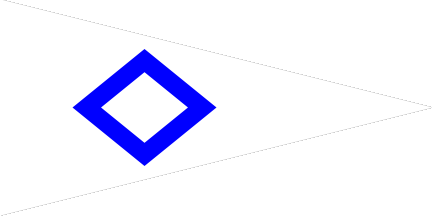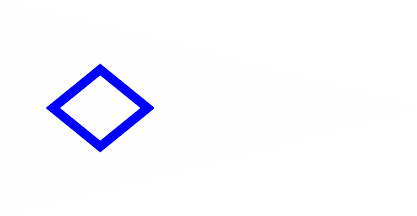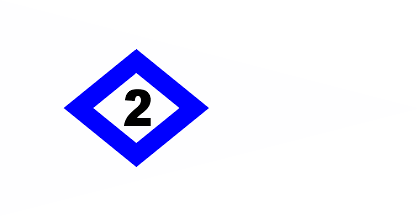
2002 River Police Pennant
image by Željko Heimer, 3 January 2009

Last modified: 2009-08-08 by dov gutterman
Keywords: croatia | police | lozenge |
Links: FOTW homepage |
search |
disclaimer and copyright |
write us |
mirrors

2002 River Police Pennant
image by Željko Heimer, 3 January 2009
See also:
There seems to be a non-coincidental similarity between this
pennant and the Hungarian Danube Police
pennant. The Hungarian pennant, however, is not 1:2 in proportion
but rather 3:5 and the shape of its lozenge is different from the
Croatian pennant shown in the Album.
Ivan Sache, 16 September 2000
I do not think that it is coincidence, either, however, I have
no proofs. Though, I can give you some forther details regarding
the Croatian pennant and some hints on where to look for possible
former Yugoslav version. Also, L'Album needs some corrections.
The two legal documents are determining the river police pennat,
but carring the same name one replacing the other:
- Pravilnik o isticanju i vijanju zastave trgovacke mornarice
Republike Hrvatske i isticanju znakova na brodovima trgovacke
mornarice Republike Hrvatske na unutarnjim plovnim putevima, 25.
veljace 1992.; Narodne novine br. 16/92, 26. ozujka 1992.
- Pravilnik o isticanju i vijanju zastave trgova?ke mornarice
Republike Hrvatske i isticanju znakova na brodovima
trgovacke mornarice Republike Hrvatske na unutarnjim plovnim
putevima, 22. svibnja 2000.; Narodne novine br. 56/00, 6. lipnja
2000.
(The Regulations on hoisting and flying of the Republic of
Croatia merchant flag, and the use of signals on the Republic of
Croatia merchant navy ships on the inner navigable watterways,
adopted 25 Febuary 1992, published in the official gatette on 26
March 1992, readopted 22 May 2000, puiblished 6 June 2000.)
Both regulations came in effect on the eight day of their issue
in the official gazette, so on 2 April 1992 and 13 June 2000
respectivly.
In the both regulations the pennant is determined in article 5,
being almost word for word the same in the two regulations, the
diferences does not consider us here. The wording of the name of
the pennant is slightly different, the 2000 regulation replacing
word "organ" with its synonim "tijelo":
"Plamenac brodova i camaca organa/tijela nadleznih za
sigurnost unutrasnje plovidbe" (meaning Pennant of the ships
and boats of organs in charge for the security of inner
navigation).
However, the images attached to the regulations (that are
considered part of those) are rather different, resulting in two
different designs of this pennant. So, let's take a look at the
design as prescribed in the text. The rhombus is prescribed to be
white with blue border. The horizontal diagonal is 80 cm,
vertical 65 cm, width of the blue border is 10 cm, and the height
of the black number inscribed in it is 20 cm. (same description
in both regulations). Both regulations allow this to be
proportionally decreased or increased in size. The pennant is in
shape of triangle with two sides being 1 m long and base of 0.50
meter (so it is not quite 1:2 ratio! - more closely 1:1.9365).
The 1992 image shows the rhombus with much thinner border then
described above. I explain it that they measured the width along
the horizontal axis, so that what is gained is the length of the
white rhombus 60 cm, so providing much thionner blue border. The
images does not have any indication of what the number might be,
though there is little doubt that the number was indeed used.
The 2000 regulations provide now the image that is much more
consistent with the text of the regulation. Now the blue borderis
considerably thicker, to conform with 10 cm requirement. The
number example is provided, showing a large bold number 2. The
position and size of the rhombus in the triangle is somewhat
changed, too.
It is my guess that the numbers are unique only within one
"police station" (whatever is called the unit of the
police organization on rivers), probably within counties. An
other, even remoter guess is
that in no county there is need for two-cifer numbers). In my
rare instances being along navigable rivers, I have tryed to
notice these pennants, but I have seen none at all, even if I
have seen several police boats. But, indeed it would be
interesting to know how are these used in practice, and if the
difference of the two regulations had any influence at all.
Both regulations are available on line on <www.nn.hr/clanci/sluzbeno/1992/0340.htm>
and <www.nn.hr/clanci/sluzbeno/2000/1239.htm>
together with images as has been printed in the official gazette.
Željko Heimer, 18 September 2000
The official gazette Narodne novine nr. 138/2008 of 28
November 2008 issued a new regulation on inland navigation, which
include some flag relevant determinations: Pravilnik o plovidbi
na unutarnjim vodama, Ministarstvo mora, prometa i
infrastrukture, 13. 11. 2008.
The most unusual determination of the Regulations is one that I
have not been aware of previously and of which I have not heard
being reported from other national regulations - that the ensigns
may be replaced with rigid panels of the same design! If this is
so, it introduces a new class of "rigid flags"...
The Article 31. section (7) determines "The vessels with
crew are obliged, when navigating during daylight, to hoist on
its stern a flag of state affiliation. Fast vessels may, instead
of the state affiliation flag, set up a panel matching the flag
in regard to the shape and colours."
The Article 37 determines the shape and size of all flags
determined with the Regulations:
"(1) Unless it is otherwise prescribed in these Regulations,
the flags and the panels prescribed with these Regulations should
be rectangular in shape and their colours should not be faded nor
dirty.
(2) The dimensions of the flags and the panels should be large
enough to be clearly seen. It shall be considered that this
condition is met:
1. for the flags and the panels: only if the length and width of
the panels and the flags is at least 1m or 0.6 m for boats,
2. for the pennants: only if the length is at least 1 m and width
next to the mast at least 0,5 m."
Article 41 determines prohibition of use of flags and other
objects that would be confused with or would that the vessels
that are unable to maneuver, beside the other obfuscate the
signals prescribed
Article 64 determines signals, should have hoisted or being waved
granted priority of passage in places where such priotities are a
red flag.
Article 65 determines that vessels that were regulated by
authorities, should have a red nets and other fishing gear in
vicinity of navigation routes should pennant hoisted.
Article 68 determines that the fishing be marked with adequate
number of for "technical vessels" performing works,
soundings and similar, yellow flags (or yellow buoys).
Article 69 determines flags when they have to be protected from
side(s) of such vessel where the navigating passage is free, a
bicolour waves (produced by other vessels passing by). On the
flag of red over white should be while a simple red flag should
be set on the side where the way is hoisted (or two flags, the
upper being red and lower white), blocked. These flags may be
with panels of standard set of signals, having red-white-red
replaced with panels of the same design, but may also be replaced
horizontal stripes for blocked and determines that each foreign
vessel while navigating in the territorial green-white-green
vertical stripes for free way.
Article 71 determines that each foreign vessel while navigating
in the territorial waters of Croatia and when entering a Croatian
harbour should hoist the flag of Croatia on the foremast.
Article 74 determines that harbor authorities vessels should have
on each of its sides a signal shaped as a rhombus coloured white
with a blue border, and beside, they should have hoisted the flag
of Croatia and a white pennant with the same rhombus symbol
(apparently, the number within the pennant is not required any
more).
Article 75 determines various distress signals that may be used
from vessels, including flag related:
- a flag or any other item being circularly waved
- a flag hoisted above a balloon or anything resembling a balloon
Article 77 prescribe similarly to 69 above, a red and white flag
for vessels that should not be disturbed by the waves produced
from passing of other vessels, although such flags now may be
replaced with the panels.
In Article 81 is prescribed that each vessel performing diving
activities should have a "faitful reproduction of the flag
ťAŤ of the International Signal Code" although other
non-flag signals are also permited (per article 79).
Article 97 determine regulations when a vessel is moving upstream
on the opposite side riverway (leaving the downstram
passing vessels its right side free for passage) - these vessels
should wave a light blue flag, or should have a light blue panel
together with a flashing white light.
In the appendix is a list of various signals, where flags are
mentioned:
- a red flag - fobidden passage
- two red flags one above the other signals such extended
prohibition.
Actually, a very similar, if not entirely equal, determinations
are already present in the previous regulations of the same name
of 2002 (NN 50/2002).
However, to the best of my knowledge, neither 2002 nor this new
2007 regulations does not supersede the determinations of the
2000 regulations that determine the white river police pennant to
have a black number within the blue voided rhombus. I am not sure
if this is an oversight of the legislator and that the number is
no longer intended to be part of the pennant, or maybe I have
misinterpreted something and the new regulations are indeed
intended to supersede the 2000 regulations.
On the other hand, in spite of looking for the river police
pennant hoisted on vessels on any chance that I was looking for
to spot, I have personally never seen it in use nor have I seen
it on any photos of such ships. This certainly does not mean that
they are not used.
Željko Heimer, 3 January 2009
These regulations very much resemble those current, now or in
the past, on the Rhine including
the use of rigid panels which may be replaced by flags
and vice versa.
Jan Mertens, 4 January 2009

image by Željko Heimer, 18 September 2000
Croatian River Police - White pennant (1:2) charged with a
blue lozenge. The lozenge includes the number of the boat.
Source: Album des Pavillons, correction #29 (February
1998) [pay].
Ivan Sache, 16 September 2000
Here is 1992 pennant , similar to L'Album image, also without
number (but in real flags some number surely was in there).
Željko Heimer, 18 September 2000

image by Željko Heimer, 18 September 2000